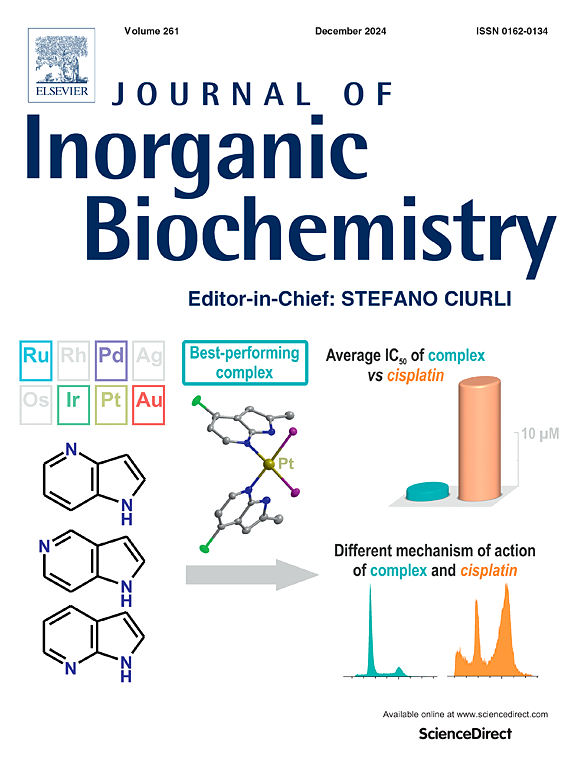Reduction of O2 and NO in flavodiiron proteins - Tuning the energy landscape by second sphere ligation variations
IF 3.8
2区 化学
Q2 BIOCHEMISTRY & MOLECULAR BIOLOGY
引用次数: 0
Abstract
Flavodiiron proteins (FDPs) constitute a large family of non-heme iron enzymes present in all domains of life. They play important roles as scavengers and detoxifiers by efficiently reducing both O and NO. The primary ligands of the diiron active site in all FDPs are highly conserved, indicating that the basic reaction mechanisms for O and NO reduction, respectively, are the same. However, the reduction activity varies significantly between different FDPs. By comparing FDPs from two different species, Thermotoga maritima and Desulfovibrio gigas, we investigate to what extent variations in the second sphere ligation can explain differences in reduction activities. Comparisons are also made between wildtype and two variants of Thermotoga maritima FDP. We use Density functional theory (DFT) calculations on a number of FDP active site models to study the reaction mechanisms for both O and NO reduction. For reduction of O we conclude that differences in activity cannot be explained by differences in the first or second active site coordination spheres, which is mainly due to a low barrier for O![]() O bond cleavage after one proton-coupled reduction step. For NO reduction however, the rate-limiting barrier for NO formation, a hyponitrite rotation, is high enough to be involved in the overall rate limitation. We show that second sphere residues, such as Tyr26 in Desulfovibrio gigas FDP, that can form hydrogen bonds to the rotating hyponitrite, decrease the barrier. Differences in NO reduction rate among different FDPs are most likely determined by the variation in such second sphere residues.
O bond cleavage after one proton-coupled reduction step. For NO reduction however, the rate-limiting barrier for NO formation, a hyponitrite rotation, is high enough to be involved in the overall rate limitation. We show that second sphere residues, such as Tyr26 in Desulfovibrio gigas FDP, that can form hydrogen bonds to the rotating hyponitrite, decrease the barrier. Differences in NO reduction rate among different FDPs are most likely determined by the variation in such second sphere residues.

黄二铁蛋白中O2和NO的还原-通过第二球连接变化调整能量景观
黄二铁蛋白(FDPs)构成了一个非血红素铁酶大家族,存在于生命的各个领域。它们通过有效地还原O2和NO而发挥清道夫和解毒剂的重要作用。所有FDPs中双铁活性位点的伯配体高度保守,表明O2还原和NO还原的基本反应机制是相同的。然而,不同fdp之间的还原活性差异很大。通过比较两种不同物种(Thermotoga marima和Desulfovibrio gigas)的fdp,我们研究了第二球连接的变化在多大程度上可以解释还原活性的差异。并对野生型和两个变异体进行了比较。我们利用密度泛函理论(DFT)计算了多个FDP活性位点模型,研究了O2和NO还原的反应机理。对于O2的还原,我们得出结论,活性的差异不能用第一或第二活性位点配位球的差异来解释,这主要是由于一个质子偶联还原步骤后OO键的切割势垒较低。然而,对于NO还原,N2O形成的限速屏障,即次亚硝酸盐旋转,足够高,足以参与总体速率限制。我们发现第二球残基(如Desulfovibrio gigas FDP中的Tyr26)可以与旋转的次亚硝酸盐形成氢键,从而降低了屏障。不同fdp之间NO还原率的差异很可能是由这种第二球残留物的变化决定的。
本文章由计算机程序翻译,如有差异,请以英文原文为准。
求助全文
约1分钟内获得全文
求助全文
来源期刊

Journal of Inorganic Biochemistry
生物-生化与分子生物学
CiteScore
7.00
自引率
10.30%
发文量
336
审稿时长
41 days
期刊介绍:
The Journal of Inorganic Biochemistry is an established international forum for research in all aspects of Biological Inorganic Chemistry. Original papers of a high scientific level are published in the form of Articles (full length papers), Short Communications, Focused Reviews and Bioinorganic Methods. Topics include: the chemistry, structure and function of metalloenzymes; the interaction of inorganic ions and molecules with proteins and nucleic acids; the synthesis and properties of coordination complexes of biological interest including both structural and functional model systems; the function of metal- containing systems in the regulation of gene expression; the role of metals in medicine; the application of spectroscopic methods to determine the structure of metallobiomolecules; the preparation and characterization of metal-based biomaterials; and related systems. The emphasis of the Journal is on the structure and mechanism of action of metallobiomolecules.
 求助内容:
求助内容: 应助结果提醒方式:
应助结果提醒方式:


